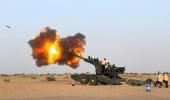DRDO's failures over the decades have contributed significantly to India becoming the world's biggest weapons importer, points out Lieutenant General Prakash Katoch (retd).

The government-appointed K Vijay Raghavan committee for restructuring the Defence Research and Development Organisation to develop high-end technologies for future warfare submitted its report to the government two months ago.
DRDO headquarters is supposed to get back to the government in three months. What happens next only time will tell.
But it may be recalled that the corporatisation (which should have actually privatised) of the Ordnance Factory Board and the 41 Ordnance Factories under it took three studies over a number of years.
Then too, all that happened was their conversion to DPSUs with the same management, same workers and the same work culture.
Not surprising, facing criticism for poor output, the advisor to the defence minister was forced to say last year that these DPSUs be allowed some time -- how much only to get their act together?
In a report tabled in Parliament in December 2022, the Comptroller and Auditor General had pointed out DRDO's 'history of failures' that included even 'mission-mode' high-priority projects that have 'high outcome certainty, as they depend on technologies that are already available, proven and readily accessible'.
According to CAG, there were projects that DRDO declared as success even though they did not achieve key objectives.
'In 119 of 178 projects,' said the CAG report, 'the original time schedules could not be adhered to. In 49 cases, the additional time was in fact more than 100 per cent of the original timeframe.'
'Overall, delays ranged from 16 to 500 per cent, and extensions for completion of projects were taken multiple times.'
Minister of State for Defence Ajay Bhatt in a written response to a query in the Rajya Sabha on February 22, 2023, said 'as on date, DRDO is working on 55 mission mode projects out of which 23 projects are delayed'.
CAG has periodically pointed out DRDO's delayed projects, cost overruns, sub-standard products and product costs higher than the same products available off-the-shelf in the open market.
DRDO's failures over the decades have contributed significantly to India becoming the world's biggest weapons importer.
Despite the much vaunted indigenisation or Atmanirbhar Bharat in defence, the latest SIPRI report states that India's arms imports increased by 4.7 per cent between 2014 and 2018 and 2019 and 2023, making it the world's biggest arms importer in 2019 to 2023 with a 9.8 percent share of all arms imports.
DRDO's failures span from its inability in provisioning a state-of-the-art assault rifle, aero engine for jet fighter aircraft to a state-of-the-art unmanned aerial vehicle (UAV) for the armed forces despite the UAVs' high importance in the battlefield observed in the Armenia-Azerbaijan conflict, Ukraine, the Red Sea and arming of China's Peoples' Liberation Army.
This has resulted in India depending on foreign procurement with the Israeli Searcher, Heron Mark-I and Mark II drones largely making up for the requirement of almost 150 UAVs in this category.
Faced with criticism and the specter of restructuring, DRDO has gone on the offensive.
Sponsored media and articles blame the Army for delays in projects like the Futuristic Infantry Combat Vehicle (FICV) and the Arjun Mk-1A.
One sponsored article claims the Army has always given stepmotherly treatment to DRDO by favouring the Russian T-90 tank over DRDO's Arjun Tank!
It further says that the Arjun Tank Project could suffer another 'devastating delay' thanks to the Army's decades-long reluctance to back it.
The reason being given is Germany shutting down the production line of the German-made 1400 HP MTU MB 838 Ka-501 V10 diesel-engine, powering the Arjun Mk-1 tank.
Here the question is, did the Army ask for the German diesel engine for the Arjun Mk-1 tank?
Why could DRDO not produce the required engine? What about aero-engines?
How many decades have the Kaveri engine taken and with what end results?
Shouldn't DRDO be ashamed that the J40 jet engine by the Indian start-up DG Propulsion has successfully clogged an one-hour endurance test already.
What about the finances and man-hours wasted on the Tapas BH-201 UAV?
A perpetual DRDO crib is Army GSQRs 'asking for the moon', as well as subsequent changes in the GSQR sought by the Army.
Closer scrutiny would indicate that the Army's GSQR is based on global developments in the defence sector, certainly not science fiction.
If DRDO feels this is asking for the moon, this should be pointed out at the very beginning rather than grabbing it with both hands by green horn scientists to avail development funds.
A second alternative for DRDO is to study the GSQR and propose a workable 'interim' prototype and the final 'prototype' giving time schedules for both.
As for the Army seeking subsequent changes in GSQR, shouldn't this be viewed in the backdrop of rapid technological changes and DRDO projects taking decades to fructify.
Also, the Army's projections to DRDO can hardly be equated with that of the Navy which is a smaller service.
The cold truth is that DRDO is the biggest hindrance to privatisation, the latter being the need of the hour in order to speed up self-reliance.
Privatisation in the defence sector is catching up, but far from the required level.
DRDO is adept at taking over inventions in the private sector, aside from other reasons, mass production facilities for financial profiting.
The Services, however, continue their efforts in concert with private players.
The Army is currently working with 340 indigenous defence industries for fructification of 230 contracts by 2025, which entails an outlay of Rs 2.5 lakh crore.
Admittedly, DRDO has shown sporadic sparks of brilliance, the hallmark being missile development, for which the credit must go to A P J Abdul Kalam.
At times, fate has also played its role.
The Akash Missile System developed as a replacement of the Russian Kvadrat to provide mobile air defence cover for mechanised forces failed miserably during trials.
It could not negotiate even small sand dunes and could not take on slow-moving helicopters either.
Therefore, it was given to the Air Force as part of a layered point air defence in conjunction with other air defence systems.
Later, it was later introduced in the Army as well.
In addition to its main agenda of suggesting ways to reform DRDO and create an indigenous defence production ecosystem, the K Vijay Raghavan committee report also recommends a larger role to the private sector in defence, limiting DRDO's role to research and development without being involved in developing prototypes or technology demonstrators.
Also, any production and further development should be done by selected private players or public sector undertakings.
Hopefully, this will be followed in real earnest because the governmental defence-industrial set up nexus with the bureaucracy is well entrenched.
DRDO is the hen that delivers golden eggs, contributing also to whichever political party is in power.
Lieutenant General Prakash Katoch (retd), PVSM, UYSM, AVSM, SC is a former Special Forces officer.
He is a third generation army officer and participated in the 1971 India-Pakistan War and in Operation Bluestar.
He commanded a Special Forces Battalion in Sri Lanka, a Brigade on the Siachen Glacier, a Division in Ladakh and a Strike Corps in the South Western Theatre.
Feature Presentation: Aslam Hunani/Rediff.com










